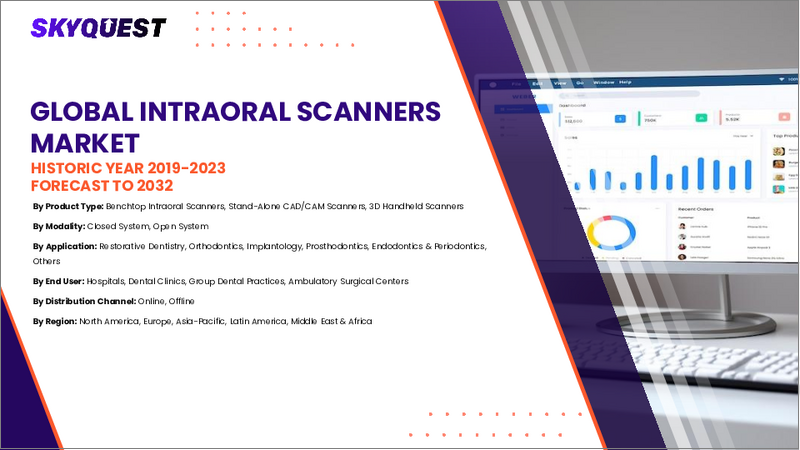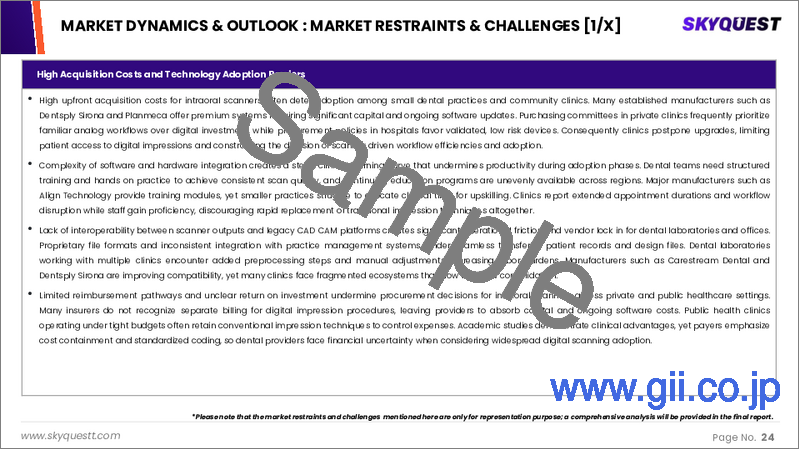|
|
市場調査レポート
商品コード
1724803
口腔内スキャナーの市場規模、シェア、成長分析:製品タイプ別、モダリティ別、エンドユーザー別、地域別 - 産業予測 2025~2032年Intraoral Scanners Market Size, Share, and Growth Analysis, By Product Type (Intraoral Scanners, Intraoral Cameras), By Modality (Closed System, Open System), By End User, By Region - Industry Forecast 2025-2032 |
||||||
|
|||||||
| 口腔内スキャナーの市場規模、シェア、成長分析:製品タイプ別、モダリティ別、エンドユーザー別、地域別 - 産業予測 2025~2032年 |
|
出版日: 2025年05月07日
発行: SkyQuest
ページ情報: 英文 157 Pages
納期: 3~5営業日
|
全表示
- 概要
- 目次
口腔内スキャナーの世界市場規模は、2023年に9億米ドルと評価され、2024年の10億1,000万米ドルから2032年には25億米ドルに成長し、予測期間(2025~2032年)のCAGRは12.0%で成長する見通しです。
歯科市場の成長は、2040年までに34.8%に達すると予測される高齢者人口の増加によって影響を受ける可能性が高いです。歯科疾患の増加は革新的なソリューションへの需要を促す可能性がありますが、インドや中国のような新興国では、専門知識の不足や鼻腔内スキャナーのような先端技術の採用といった課題があり、市場拡大の妨げになる可能性があります。しかし、従来の歯科用印象からデジタルスキャニング技術への移行は、患者ケアを再定義し、より迅速な納期、効率性の向上、治療結果の改善をもたらします。
目次
イントロダクション
- 調査の目的
- 調査範囲
- 定義
調査手法
- 情報調達
- 二次と一次データの方法
- 市場規模予測
- 市場の前提条件と制限
エグゼクティブサマリー
- 世界市場の見通し
- 供給と需要の動向分析
- セグメント別機会分析
市場力学と見通し
- 市場概要
- 市場規模
- 市場力学
- 促進要因と機会
- 抑制要因と課題
- ポーターの分析
主な市場の考察
- 重要成功要因
- 競合の程度
- 主な投資機会
- 市場エコシステム
- 市場の魅力指数(2024年)
- PESTEL分析
- マクロ経済指標
- バリューチェーン分析
- 価格分析
- 技術分析
口腔内スキャナー市場規模:製品タイプ別
- 市場概要
- 口腔内スキャナー
- ベンチトップ口腔内スキャナー
- スタンドアロンCAD/CAMスキャナー
- 3Dハンドヘルドスキャナー
- 口腔内カメラ
- 口腔内センサー
- スタンドアロンソフトウェア
口腔内スキャナー市場規模:モダリティ別
- 市場概要
- クローズドシステム
- オープンシステム
口腔内スキャナー市場規模:エンドユーザー別
- 市場概要
- 病院
- 歯科医院
- グループ歯科診療所
- 外来手術センター
口腔内スキャナー市場規模
- 北米
- 米国
- カナダ
- 欧州
- ドイツ
- スペイン
- フランス
- 英国
- イタリア
- その他欧州地域
- アジア太平洋地域
- 中国
- インド
- 日本
- 韓国
- その他アジア太平洋地域
- ラテンアメリカ
- ブラジル
- その他ラテンアメリカ地域
- 中東・アフリカ
- GCC諸国
- 南アフリカ
- その他中東・アフリカ
競合情報
- 上位5社の比較
- 主要企業の市場ポジショニング(2024年)
- 主な市場企業が採用した戦略
- 最近の市場動向
- 企業の市場シェア分析(2024年)
- 主要企業の企業プロファイル
- 企業の詳細
- 製品ポートフォリオ分析
- 企業のセグメント別シェア分析
- 収益の前年比比較(2022~2024年)
主要企業プロファイル
- Align Technology, Inc.(USA)
- Dentsply Sirona Inc.(USA)
- 3Shape A/S(Denmark)
- Medit Corp.(South Korea)
- PLANMECA OY(Finland)
- Carestream Dental(USA)
- Shining 3D(China)
- Guangdong Launca Medical Device Technology Co. Ltd.(China)
- Condor Technologies NV(Belgium)
- Densys Ltd.(Israel)
- Institut Straumann AG(Switzerland)
- Dental Wings(Canada)
- Vatech Co Ltd.(South Korea)
- 3M Oral Care(USA)
- Heron IOS(3DISC)(Denmark)
- FREQTY(PANDA Scanner)(China)
- FUSSEN Technology(China)
- Owandy Radiology(France)
- Eighteeth Medical(China)
- Runyes Medical Instrument Co., Ltd.(China)
結論と提言
Global Intraoral Scanners Market size was valued at USD 0.9 billion in 2023 and is poised to grow from USD 1.01 billion in 2024 to USD 2.5 billion by 2032, growing at a CAGR of 12.0% during the forecast period (2025-2032).
The dental market's growth is likely to be impacted by the increasing elderly population, projected to reach 34.8% by 2040, which presents heightened vulnerability to dental issues like tooth decay and related diseases due to age-related factors. While the rise in dental conditions could prompt demand for innovative solutions, challenges such as insufficient professional expertise and the adoption of advanced technologies like internasal scanners in developing nations like India and China may hinder market expansion. However, the transition from conventional dental impressions to digital scanning technologies is redefining patient care, offering faster turnaround times, improved efficiency, and enhanced outcomes, which may offset some growth limitations and improve overall patient experiences in the dental sector.
Top-down and bottom-up approaches were used to estimate and validate the size of the Global Intraoral Scanners market and to estimate the size of various other dependent submarkets. The research methodology used to estimate the market size includes the following details: The key players in the market were identified through secondary research, and their market shares in the respective regions were determined through primary and secondary research. This entire procedure includes the study of the annual and financial reports of the top market players and extensive interviews for key insights from industry leaders such as CEOs, VPs, directors, and marketing executives. All percentage shares split, and breakdowns were determined using secondary sources and verified through Primary sources. All possible parameters that affect the markets covered in this research study have been accounted for, viewed in extensive detail, verified through primary research, and analyzed to get the final quantitative and qualitative data.
Global Intraoral Scanners Market Segments Analysis
Global Intraoral Scanners Market is segmented by Product Type, Modality, End User and region. Based on Product Type, the market is segmented into Intraoral Scanners, Intraoral Cameras, Intraoral Sensors and Stand-Alone Software. Based on Modality, the market is segmented into Closed System and Open System. Based on End User, the market is segmented into Hospitals, Dental Clinics, Group Dental Practices and Ambulatory Surgical Centers. Based on region, the market is segmented into North America, Europe, Asia Pacific, Latin America and Middle East & Africa.
Driver of the Global Intraoral Scanners Market
A key factor propelling the growth of the global intraoral scanners market is the rising demand for innovative digital dental solutions. Intraoral scanners provide notable advantages compared to conventional methods, such as quicker and more precise scanning, enhanced patient comfort, and improved treatment planning. As dental professionals increasingly recognize these benefits, including streamlined workflows and greater patient satisfaction, their adoption of intraoral scanners continues to rise. Moreover, technological advancements, including the creation of smaller and more portable scanner models, are further stimulating the expansion of the intraoral scanners industry, making these devices more accessible and appealing to practitioners worldwide.
Restraints in the Global Intraoral Scanners Market
Conversely, a notable hindrance to the expansion of the global intraoral scanners market is the elevated cost linked to these devices. The investment required for purchasing and maintaining intraoral scanners can be quite substantial, rendering them less accessible for smaller dental practices or regions with limited financial resources. Additionally, the expenses related to training dental professionals on the effective use and integration of these scanners into their workflows pose another challenge. This combination of high initial costs and the ongoing financial commitment for training can deter smaller practices from adopting this advanced technology, ultimately affecting the market's growth potential.
Market Trends of the Global Intraoral Scanners Market
The Global Intraoral Scanners market is witnessing significant growth driven by the increasing adoption of digital dentistry. Dental professionals are shifting from traditional impression methods to advanced virtual scanning technologies, which offer enhanced patient comfort, shorter chair times, and greater accuracy in restorative and orthodontic procedures. Key advancements in intraoral scanning technology, including the development of smaller, more ergonomic devices, faster scanning capabilities, and expanded software functionalities, are further propelling market expansion. Additionally, the integration of intraoral scanners with CAD/CAM systems and various dental software solutions fosters a seamless digital workflow, leading to improved patient outcomes and optimized dental practice operations.
Table of Contents
Introduction
- Objectives of the Study
- Scope of the Report
- Definitions
Research Methodology
- Information Procurement
- Secondary & Primary Data Methods
- Market Size Estimation
- Market Assumptions & Limitations
Executive Summary
- Global Market Outlook
- Supply & Demand Trend Analysis
- Segmental Opportunity Analysis
Market Dynamics & Outlook
- Market Overview
- Market Size
- Market Dynamics
- Drivers & Opportunities
- Restraints & Challenges
- Porters Analysis
- Competitive rivalry
- Threat of substitute
- Bargaining power of buyers
- Threat of new entrants
- Bargaining power of suppliers
Key Market Insights
- Key Success Factors
- Degree of Competition
- Top Investment Pockets
- Market Ecosystem
- Market Attractiveness Index, 2024
- PESTEL Analysis
- Macro-Economic Indicators
- Value Chain Analysis
- Pricing Analysis
- Technology Analysis
Global Intraoral Scanners Market Size by Product Type & CAGR (2025-2032)
- Market Overview
- Intraoral Scanners
- Benchtop Intraoral Scanners
- Stand-Alone CAD/CAM Scanners
- 3D Handheld Scanners
- Intraoral Cameras
- Intraoral Sensors
- Stand-Alone Software
Global Intraoral Scanners Market Size by Modality & CAGR (2025-2032)
- Market Overview
- Closed System
- Open System
Global Intraoral Scanners Market Size by End User & CAGR (2025-2032)
- Market Overview
- Hospitals
- Dental Clinics
- Group Dental Practices
- Ambulatory Surgical Centers
Global Intraoral Scanners Market Size & CAGR (2025-2032)
- North America (Product Type, Modality, End User)
- US
- Canada
- Europe (Product Type, Modality, End User)
- Germany
- Spain
- France
- UK
- Italy
- Rest of Europe
- Asia Pacific (Product Type, Modality, End User)
- China
- India
- Japan
- South Korea
- Rest of Asia-Pacific
- Latin America (Product Type, Modality, End User)
- Brazil
- Rest of Latin America
- Middle East & Africa (Product Type, Modality, End User)
- GCC Countries
- South Africa
- Rest of Middle East & Africa
Competitive Intelligence
- Top 5 Player Comparison
- Market Positioning of Key Players, 2024
- Strategies Adopted by Key Market Players
- Recent Developments in the Market
- Company Market Share Analysis, 2024
- Company Profiles of All Key Players
- Company Details
- Product Portfolio Analysis
- Company's Segmental Share Analysis
- Revenue Y-O-Y Comparison (2022-2024)
Key Company Profiles
- Align Technology, Inc. (USA)
- Company Overview
- Business Segment Overview
- Financial Updates
- Key Developments
- Dentsply Sirona Inc. (USA)
- Company Overview
- Business Segment Overview
- Financial Updates
- Key Developments
- 3Shape A/S (Denmark)
- Company Overview
- Business Segment Overview
- Financial Updates
- Key Developments
- Medit Corp. (South Korea)
- Company Overview
- Business Segment Overview
- Financial Updates
- Key Developments
- PLANMECA OY (Finland)
- Company Overview
- Business Segment Overview
- Financial Updates
- Key Developments
- Carestream Dental (USA)
- Company Overview
- Business Segment Overview
- Financial Updates
- Key Developments
- Shining 3D (China)
- Company Overview
- Business Segment Overview
- Financial Updates
- Key Developments
- Guangdong Launca Medical Device Technology Co. Ltd. (China)
- Company Overview
- Business Segment Overview
- Financial Updates
- Key Developments
- Condor Technologies NV (Belgium)
- Company Overview
- Business Segment Overview
- Financial Updates
- Key Developments
- Densys Ltd. (Israel)
- Company Overview
- Business Segment Overview
- Financial Updates
- Key Developments
- Institut Straumann AG (Switzerland)
- Company Overview
- Business Segment Overview
- Financial Updates
- Key Developments
- Dental Wings (Canada)
- Company Overview
- Business Segment Overview
- Financial Updates
- Key Developments
- Vatech Co Ltd. (South Korea)
- Company Overview
- Business Segment Overview
- Financial Updates
- Key Developments
- 3M Oral Care (USA)
- Company Overview
- Business Segment Overview
- Financial Updates
- Key Developments
- Heron IOS (3DISC) (Denmark)
- Company Overview
- Business Segment Overview
- Financial Updates
- Key Developments
- FREQTY (PANDA Scanner) (China)
- Company Overview
- Business Segment Overview
- Financial Updates
- Key Developments
- FUSSEN Technology (China)
- Company Overview
- Business Segment Overview
- Financial Updates
- Key Developments
- Owandy Radiology (France)
- Company Overview
- Business Segment Overview
- Financial Updates
- Key Developments
- Eighteeth Medical (China)
- Company Overview
- Business Segment Overview
- Financial Updates
- Key Developments
- Runyes Medical Instrument Co., Ltd. (China)
- Company Overview
- Business Segment Overview
- Financial Updates
- Key Developments





